Engineers at Rolls-Royce in Derby, UK, have successfully tested a key component of the UltraFan engine design. For the first time, all composite elements of the Advanced Low Pressure system (ALPS), including fan blades, a fan case and annulus fillers, were tested together on a donor engine.
Rolls-Royce promises that the UltraFan will redefine the world of jet engines, delivering significant weight, noise and fuel burn reductions, and will be 25% more efficient than a first-generation Trent engine.
The engine parts are manufactured using fully automated construction methods at Rolls-Royce’s Composites Technology Facility. Each fan blade is made robotically, building up around 500 layers of carbon fibre materials. Heat and pressure are then applied, and each blade is finished with a leading titanium edge, which offers extreme protection against foreign objects and bird strikes. When laid out, the layers of composite material that make up the fan blades and the fan case on this engine would stretch from London to Leeds.
The Advanced Low Pressure System demonstrates Rolls-Royce’s IntelligentEngine vision. Each blade has a digital twin – an identical virtual copy. During testing, vast amounts of data will be collected that will be fed into the digital twins, and allow engineers to predict how each blade will perform in service.
Ash Owen, Rolls-Royce, Chief Engineer, Civil Aerospace Demonstrator Programmes said: “These incredible technologies are taking our world-leading fan efficiency to the next level. More than a decade of research and development has brought us to this point and I’m confident that after extreme weather testing in Canada and performance testing in Germany, we can prove ALPS technology even further here in Derby, moving us one step closer to our UltraFan demonstrator.”
Current and next generation aero engines will feature in the forthcoming Airline Economics Aero Engine Yearbook 2019. Please contact the editor at victoria@aviationnews-online.com if you would like to be featured in the annual publication from Airline Economics.





